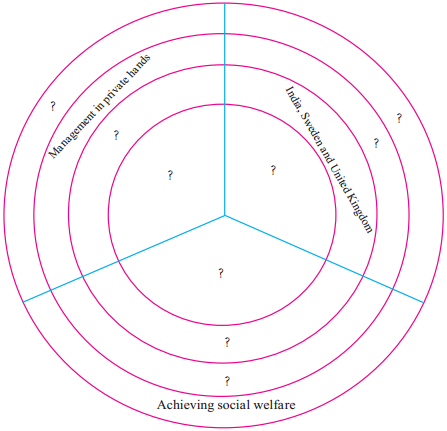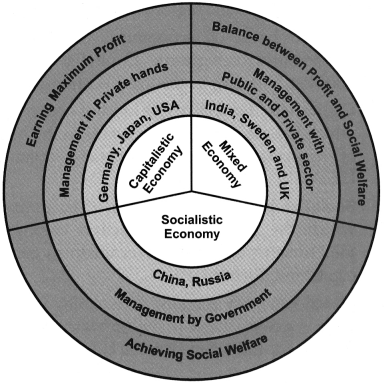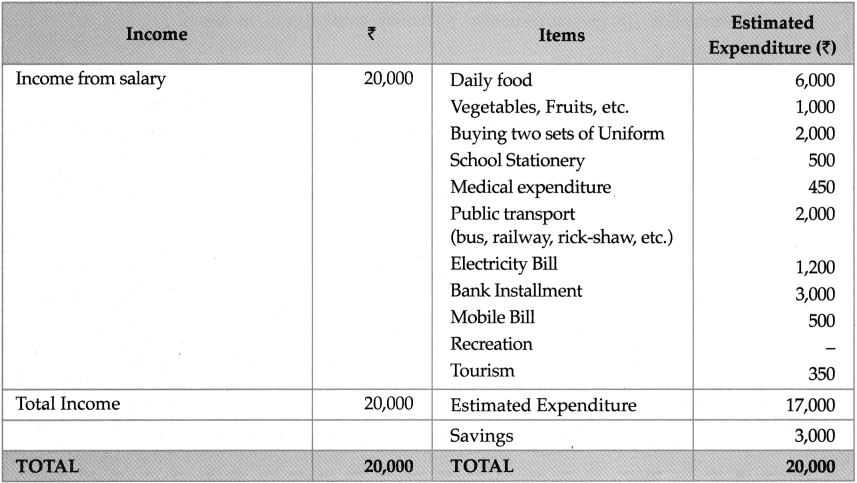Balbharti Maharashtra State Board Class 9 Geography Solutions
Chapter 8 Introduction to Economics Notes, Textbook Exercise Important Questions and Answers.
Class 9 Geography Chapter 8 Introduction to Economics Textbook Questions and Answers
1. Explain the types of economies by filling correct information in the place of questions in the circle.

Answer:


2. Give an explanation:
Question 1.
The economy begins at home.
Answer:
Question 2.
India’s economy is of mixed type.
Answer:
Question 3.
On the basis of economies, we can divide countries into three groups.
Answer:
The activities related to the production, distribution and consumption of goods and services in a specific region is called economy. On the basis of economies, countries are divided into three groups. Capitalist Economy, Socialist Economy and Mixed Economy.
3. Write the following questions in one line:
Question 1.
To which economic factor is the management of individual or family finances related?
Answer:
Management of individual or family finances is related to the economic factor of ‘income and expenditure.
Question 2.
From which Greek word is the term ‘Economics’ derived?
Answer:
The word ‘Economics’ is derived from the Greek word ‘Oikonomia’ which means family management.
Question 3.
In a capitalistic economy, to whom does the ownership and management of means of production belong?
Answer:
In a Capitalistic Economy, the ownership and management of means of production belong to the private sector.

Question 4.
What do you mean by globalisation?
Answer:
Globalisation means aligning the country’s economy with the world economy.
Class 9 Geography Chapter 8 Introduction to Economics Intext Questions and Answers
Can you tell?
Suppose this is your expenditure this month and your monthly income is? 20,000. To strike a balance between your income and your expenditure, decide that will be your preferences for expenditure.
Rewrite the table according to your preferences and discuss in class.
Answer:
Income And Expenditure Statement


Can you do it?
Question 1.
Suppose you are the finance minister of an agrarian country. Giving priority to the overall development of the country, make a five-point program.
Answer:
As a Finance Minister of an Agrarian country like India, I would focus on transforming India in five areas:
Class 9 Geography Chapter 8 Introduction to Economics Additional Important Questions and Answers
Complete the statements choosing the correct option:
Question 1.
The term economics’ is derived from Greek word
(a) oikomonia
(b) oikonomica
(c) oikonomia
(d) oikonomics
Answer:
(c) oikonomia
Question 2.
China and Russia have adopted type of economy.
(a) Socialistic
(b) Capitalistic
(c) Mixed
(d) None of these
Answer:
(a) Socialistic

Question 3.
The main motive of a economy is to earn profit.
(a) Mixed
(b) Capitalistic
(c) Simple
(d) Socialistic
Answer:
(b) Capitalistic
Question 4.
The main aim of Socialistic economy is to achieve
(a) social welfare
(b) profit
(c) injustice
(d) tolerance
Answer:
(a) social welfare
Question 5.
Germany is an example of a country which has adopted economy.
(a) Simple
(b) Socialistic
(c) Mixed
(d) Capitalistic
Answer:
(d) Capitalistic
Question 6.
Adam Smith has defined economics as the
(a) science of knowledge
(b) science of wealth
(c) science of peace
(d) science of needs
Answer:
(b) science of wealth
Question 7.
means making the country’s economy aligned with world economy.
(a) Liberalisation
(b) Privatisation
(c) Globalisation
(d) None of these
Answer:
(c) Globalisation

Question 8.
Economics is an important science.
(a) social
(b) political
(c) physical
(d) alternative
Answer:
(a) social
Question 9.
One of the main functions of the economy is to the production cost
(a) maximize
(b) inflate
(c) increase
(d) minimize
Answer:
(d) minimize
Question 10.
An economy strives to create a balance between resources and needs.
(a) unlimited, limited
(b) limited, unlimited
(c) plentiful, limited
(d) limited, scarce
Answer:
(b) limited, unlimited
Question 11.
is known as the Father of Economics.
(a) Lionel Robbins
(b) Prof. Samuelson
(c) Amartya Sen
(d) Adam Smith
Answer:
(d) Adam Smith
Question 12.
Economics is a science which studies human behaviour as a relationship between and scarce which have alternative uses.
(a) means, ends
(b) people, resources
(c) money, land
(d) ends, means
Answer:
(d) ends, means

Question 13.
We understand from economics, how to use, money, land and effectively.
(a) minerals, factory
(b) time, labour
(c) food grains, machines
(d) people, power
Answer:
(b) time, labour
Question 14.
On a global level, there are types of economies.
(a) four
(b) two
(c) three
(d) five
Answer:
(c) three
Question 15.
economy is a borderless economy.
(a) State
(b) Town
(c) Village
(d) World
Answer:
(d) World
Question 16.
In Globalisation, there is trade and all restrictions on are set aside.
(a) restricted, economy
(b) free, investments
(c) no, activity
(d) zero, labour
Answer:
(b) free, investments
Match the column
Answer:
(1 – b),
(2 – c),
(3 – a)
Answer the following questions in one sentence each:
Question 1.
Define Economics.
Answer:
According to Lionel Robbins, “Economics is a science which studies human behaviour as a relationship between ends and scarce means which have alternative uses”.

Question 2.
What is an Economy?
Answer:
The activities related to the production, distribution and consumption of goods and services in a specific region is called an economy.
Question 3.
What is a Capitalistic Economy?
Answer:
The economy in which the ownership and management of the means of production is in the hands of private individuals is called as a Capitalistic Economy.
Question 4.
What is the main aim of a Capitalistic Economy?
Answer:
The main aim of a Capitalistic Economy is to earn maximum profit.
Question 5.
Which countries have adopted Capitalistic Economy?
Answer:
Germany, Japan and USA are the examples of countries which have adopted Capitalistic economy.
Question 6.
What do you mean by Socialistic economy?
Answer:
The economy in which the means of production belong to the society as a whole i.e. the government’s control is known as a Socialistic economy.
Question 7.
What is the main aim of a Socialistic economy?
Answer:
The main aim of a Socialistic economy is to achieve social welfare.

Question 8.
Name Adam Smith’s book and year of publication.
Answer:
Adam Smith’s book is titled ‘Wealth of Nations/ and was published in 1776.
Question 9.
What are the types of economy at the global level?
Answer:
Capitalist, Socialist and Mixed Economy are the types of economy at the global level
Question 10.
Which economist is known as Father of Economics?
Answer:
Adam Smith is known as Father of Economics.
Question 11.
How does Adam Smith describe Economics in his ‘Wealth of Nations’?
Answer:
In the book ‘Wealth of Nations’ Adam Smith describes Economics as ‘the science of wealth’.
Question 12.
What is the World Economy?
Answer:
World Economy is a borderless economy in which natural resources, profit, services, capital, labour and technology flow freely across the countries.
Distinguish between Capitalist Economy and Socialist Economy.
Answer:
Answer the following in detail.
Question 1.
Explain the functions of an economy.
Answer:
Every country has a different economy. But the main functions of an economy are similar. Some of the main functions of an economy are:

Question 2.
Explain the importance of Economics.
Answer:
Economics is an important Social Science Subject.
Question 3.
Name the factors affecting an economy.
Answer:
The factors affecting an economy are:
Question 4.
Write a description of Economics given by Lionel Robbins.
Answer:
Question 5.
Explain the nature of the Capitalist Economy.
Answer:

Question 6.
Explain the nature of the Socialist Economy.
Answer:
Question 7.
What are the main features (components) of the economy?
Answer:
Question 8.
Explain the nature of globalisation.
Answer:
Chapter 8 Introduction to Economics Notes, Textbook Exercise Important Questions and Answers.
Class 9 Geography Chapter 8 Introduction to Economics Textbook Questions and Answers
1. Explain the types of economies by filling correct information in the place of questions in the circle.

Answer:

2. Give an explanation:
Question 1.
The economy begins at home.
Answer:
Question 2.
India’s economy is of mixed type.
Answer:
Question 3.
On the basis of economies, we can divide countries into three groups.
Answer:
The activities related to the production, distribution and consumption of goods and services in a specific region is called economy. On the basis of economies, countries are divided into three groups. Capitalist Economy, Socialist Economy and Mixed Economy.
3. Write the following questions in one line:
Question 1.
To which economic factor is the management of individual or family finances related?
Answer:
Management of individual or family finances is related to the economic factor of ‘income and expenditure.
Question 2.
From which Greek word is the term ‘Economics’ derived?
Answer:
The word ‘Economics’ is derived from the Greek word ‘Oikonomia’ which means family management.
Question 3.
In a capitalistic economy, to whom does the ownership and management of means of production belong?
Answer:
In a Capitalistic Economy, the ownership and management of means of production belong to the private sector.
Question 4.
What do you mean by globalisation?
Answer:
Globalisation means aligning the country’s economy with the world economy.
Class 9 Geography Chapter 8 Introduction to Economics Intext Questions and Answers
Can you tell?
Suppose this is your expenditure this month and your monthly income is? 20,000. To strike a balance between your income and your expenditure, decide that will be your preferences for expenditure.
Rewrite the table according to your preferences and discuss in class.
| Sr.No. | — | Estimated Expenditure (₹) |
| 1. | Daily food | 6,000 |
| 2. | Buying two sets of Uniform | 2,000 |
| 3. | School Stationery | 500 |
| 4. | Medical expenditure | 450 |
| 5. | Recreation | 500 |
| 6. | Mobile Bill | 1,000 |
| 7. | Vegetables, Fruits, etc. | 1,000 |
| 8. | Public transport (bus, railway, rick-shaw, etc.) | 2,600 |
| 9. | Electricity Bill | 1,500 |
| 10. | Tourism | 4,000 |
| 11. | Bank Installment | 3,000 |
| Total Expenditure | 22,550 |
Income And Expenditure Statement

Can you do it?
Question 1.
Suppose you are the finance minister of an agrarian country. Giving priority to the overall development of the country, make a five-point program.
Answer:
As a Finance Minister of an Agrarian country like India, I would focus on transforming India in five areas:
Class 9 Geography Chapter 8 Introduction to Economics Additional Important Questions and Answers
Complete the statements choosing the correct option:
Question 1.
The term economics’ is derived from Greek word
(a) oikomonia
(b) oikonomica
(c) oikonomia
(d) oikonomics
Answer:
(c) oikonomia
Question 2.
China and Russia have adopted type of economy.
(a) Socialistic
(b) Capitalistic
(c) Mixed
(d) None of these
Answer:
(a) Socialistic
Question 3.
The main motive of a economy is to earn profit.
(a) Mixed
(b) Capitalistic
(c) Simple
(d) Socialistic
Answer:
(b) Capitalistic
Question 4.
The main aim of Socialistic economy is to achieve
(a) social welfare
(b) profit
(c) injustice
(d) tolerance
Answer:
(a) social welfare
Question 5.
Germany is an example of a country which has adopted economy.
(a) Simple
(b) Socialistic
(c) Mixed
(d) Capitalistic
Answer:
(d) Capitalistic
Question 6.
Adam Smith has defined economics as the
(a) science of knowledge
(b) science of wealth
(c) science of peace
(d) science of needs
Answer:
(b) science of wealth
Question 7.
means making the country’s economy aligned with world economy.
(a) Liberalisation
(b) Privatisation
(c) Globalisation
(d) None of these
Answer:
(c) Globalisation
Question 8.
Economics is an important science.
(a) social
(b) political
(c) physical
(d) alternative
Answer:
(a) social
Question 9.
One of the main functions of the economy is to the production cost
(a) maximize
(b) inflate
(c) increase
(d) minimize
Answer:
(d) minimize
Question 10.
An economy strives to create a balance between resources and needs.
(a) unlimited, limited
(b) limited, unlimited
(c) plentiful, limited
(d) limited, scarce
Answer:
(b) limited, unlimited
Question 11.
is known as the Father of Economics.
(a) Lionel Robbins
(b) Prof. Samuelson
(c) Amartya Sen
(d) Adam Smith
Answer:
(d) Adam Smith
Question 12.
Economics is a science which studies human behaviour as a relationship between and scarce which have alternative uses.
(a) means, ends
(b) people, resources
(c) money, land
(d) ends, means
Answer:
(d) ends, means
Question 13.
We understand from economics, how to use, money, land and effectively.
(a) minerals, factory
(b) time, labour
(c) food grains, machines
(d) people, power
Answer:
(b) time, labour
Question 14.
On a global level, there are types of economies.
(a) four
(b) two
(c) three
(d) five
Answer:
(c) three
Question 15.
economy is a borderless economy.
(a) State
(b) Town
(c) Village
(d) World
Answer:
(d) World
Question 16.
In Globalisation, there is trade and all restrictions on are set aside.
(a) restricted, economy
(b) free, investments
(c) no, activity
(d) zero, labour
Answer:
(b) free, investments
Match the column
| Group A | Group B | |
| (1) Capitalist economy | (a) India | |
| (2) Socialist economy | (b) USA | |
| (3) Mixed economy | (c) Russia | |
(1 – b),
(2 – c),
(3 – a)
Answer the following questions in one sentence each:
Question 1.
Define Economics.
Answer:
According to Lionel Robbins, “Economics is a science which studies human behaviour as a relationship between ends and scarce means which have alternative uses”.
Question 2.
What is an Economy?
Answer:
The activities related to the production, distribution and consumption of goods and services in a specific region is called an economy.
Question 3.
What is a Capitalistic Economy?
Answer:
The economy in which the ownership and management of the means of production is in the hands of private individuals is called as a Capitalistic Economy.
Question 4.
What is the main aim of a Capitalistic Economy?
Answer:
The main aim of a Capitalistic Economy is to earn maximum profit.
Question 5.
Which countries have adopted Capitalistic Economy?
Answer:
Germany, Japan and USA are the examples of countries which have adopted Capitalistic economy.
Question 6.
What do you mean by Socialistic economy?
Answer:
The economy in which the means of production belong to the society as a whole i.e. the government’s control is known as a Socialistic economy.
Question 7.
What is the main aim of a Socialistic economy?
Answer:
The main aim of a Socialistic economy is to achieve social welfare.
Question 8.
Name Adam Smith’s book and year of publication.
Answer:
Adam Smith’s book is titled ‘Wealth of Nations/ and was published in 1776.
Question 9.
What are the types of economy at the global level?
Answer:
Capitalist, Socialist and Mixed Economy are the types of economy at the global level
Question 10.
Which economist is known as Father of Economics?
Answer:
Adam Smith is known as Father of Economics.
Question 11.
How does Adam Smith describe Economics in his ‘Wealth of Nations’?
Answer:
In the book ‘Wealth of Nations’ Adam Smith describes Economics as ‘the science of wealth’.
Question 12.
What is the World Economy?
Answer:
World Economy is a borderless economy in which natural resources, profit, services, capital, labour and technology flow freely across the countries.
Distinguish between Capitalist Economy and Socialist Economy.
Answer:
| Capitalist Economy | Socialist Economy |
| (i) Ownership and management of means of production is in the hands of the private individuals. (ii) To earn maximum profit is the main aim of the Capitalist Economy. (iii) The USA, Germany and Japan have Capitalist Economy. |
The means of production belong to the society as a whole and are under the control of the government. To achieve social welfare is the main aim of the Socialist Economy. Russia and China have Socialist Economy. |
Question 1.
Explain the functions of an economy.
Answer:
Every country has a different economy. But the main functions of an economy are similar. Some of the main functions of an economy are:
Question 2.
Explain the importance of Economics.
Answer:
Economics is an important Social Science Subject.
Question 3.
Name the factors affecting an economy.
Answer:
The factors affecting an economy are:
Question 4.
Write a description of Economics given by Lionel Robbins.
Answer:
Question 5.
Explain the nature of the Capitalist Economy.
Answer:
Question 6.
Explain the nature of the Socialist Economy.
Answer:
Question 7.
What are the main features (components) of the economy?
Answer:
Question 8.
Explain the nature of globalisation.
Answer: